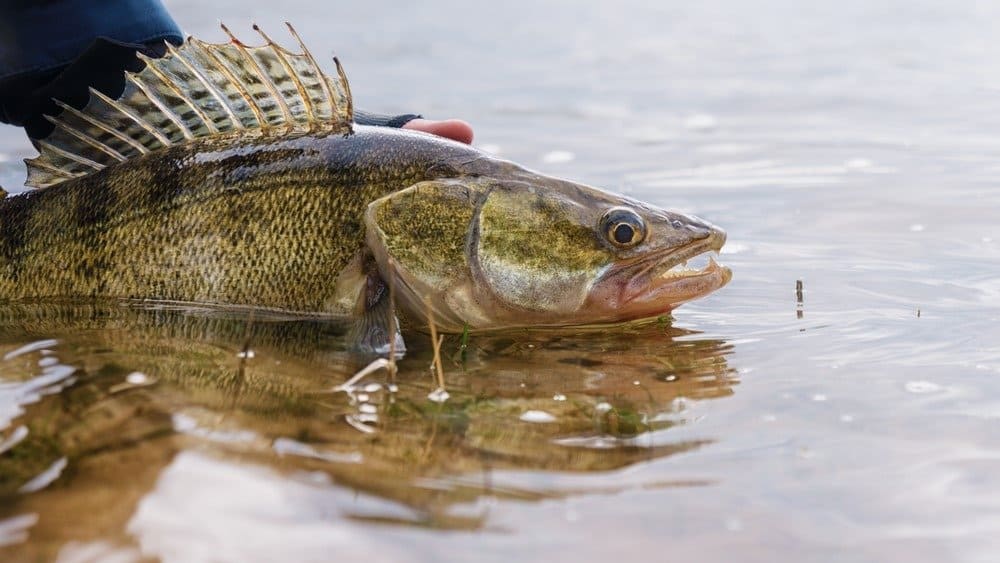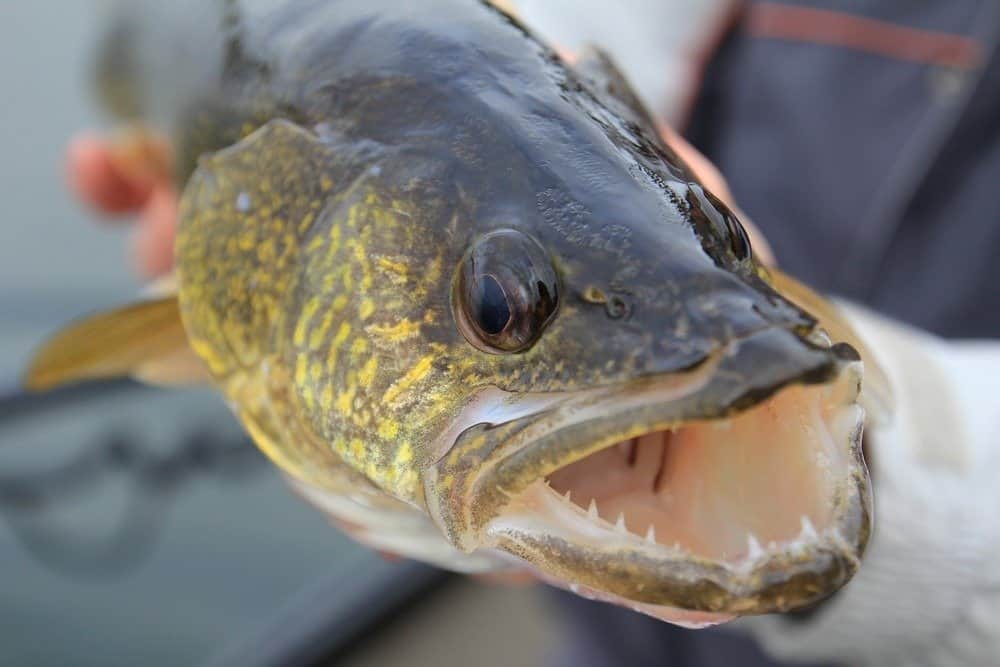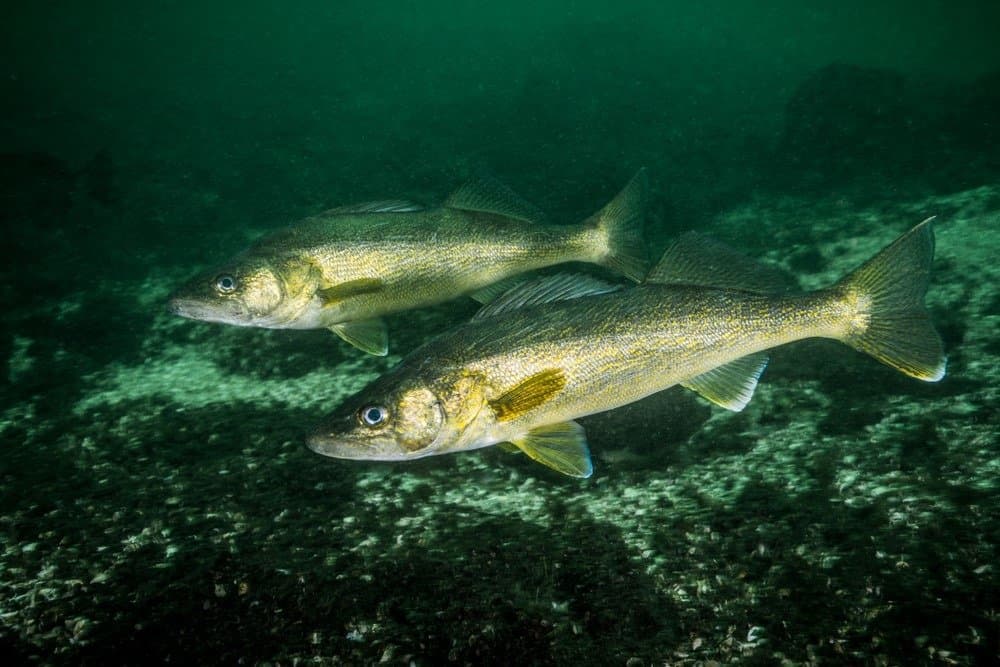Walleye Fish
Sander vitreus
Has great night vision
Advertisement
Walleye Fish Scientific Classification
- Kingdom
- Animalia
- Phylum
- Chordata
- Class
- Actinopterygii
- Order
- Perciformes
- Family
- Percidae
- Genus
- Sander
- Scientific Name
- Sander vitreus
Read our Complete Guide to Classification of Animals.
Walleye Fish Conservation Status
Walleye Fish Facts
- Prey
- Fish, insects
- Group Behavior
- School
- Fun Fact
- Has great night vision
- Estimated Population Size
- Unknown
- Biggest Threat
- Climate change
- Most Distinctive Feature
- Large, glassy eyes
- Other Name(s)
- Yellow pike, yellow pickerel
- Gestation Period
- 12-30 days
- Optimum pH Level
- 6.0-8.0
- Habitat
- Lakes, streams, rivers
- Predators
- Humans, birds, fish
- Diet
- Carnivore
- Lifestyle
- Nocturnal
- Type
- Perciforme
- Common Name
- Walleye
- Number Of Species
- 1
View all of the Walleye Fish images!
The Walleye Fish is also known as the yellow pike or yellow pickerel.

The Walleye is a species of ray-finned fish native to freshwater bodies in many states throughout the midwestern United States and in many regions of Canada. it is a popular game fish for anglers who are seeking a fun fight along with a solid meal. Its popularity in recreational fishing has prompted introduction into rivers and lakes across the United States, sometimes with negative ecological consequences. Appearance and behavior can vary slightly between local ecosystems as populations adapt to specific habitats.
3 Incredible Facts!
- State Fish: This species is the official state fish of Vermont, South Dakota, Minnesota, and multiple Canadian provinces.
- Night Vision: Walleye are nocturnal and their unique eye structures give them strong sight even in dark waters.
- Menu Item: Long sought after by fishers, walleye are a growing commercial commodity and are becoming a feature on many restaurant menus.
Classification and Scientific Name

The Walleye fish is a type of perch with the scientific name of
Sander vitreus.
©wwwarjag/Shutterstock.com
The walleye is also called yellow pike or yellow pickerel and is sometimes labeled yellow walleye to distinguish it from an extinct subspecies known as blue walleye. It’s also known simply as pickerel in Canada, although walleye are actually a type of perch and are not related to the various species officially classified as pickerel.
The scientific name for the species is Sander vitreus. The word vitreus is taken from the Latin word for glassy, which is a reference to the walleye’s distinct large, reflective eyes. This species is part of the Actinopterygii taxonomic class, Order Perciformes, Family Percidae, and Subfamily Luciopercinae.
There is currently only one known species of walleye, although there can be noticeable genetic differences between fish populations in different habitats. The blue walleye, also historically known as the blue pike, was considered a closely related species but was then reclassified as a subspecies directly related to the (yellow) walleye. However, the blue walleye’s native populations dwindled during the 20th century and it was declared extinct in 1983.
Appearance
As the largest member of the perch family, walleye reach an adult size of around 30 inches long and 20 pounds in weight. While there is some dispute about the record, the largest walleye on record was caught in 1959. The so-called Harper Walleye, named after the surname of the fisherman who caught it, was reportedly just over 40 inches long and weighed 25 pounds.

Walleye fish have lean, flexible bodies that make them fun fighters for anglers.
©FedBul/Shutterstock.com
These relatively large freshwater fish have lean, flexible bodies that make them fun fighters for anglers. They have a dark green to gold coloration along most of their body with at least five distinct black bands along the back. Their bellies are usually a white or lighter color. They have two fins along the top of their body, including one soft ray fin and another spined one. Their mouth is also lined with sharp teeth that can make removing lures a hazardous prospect.
Both the common and scientific names for walleye comes from their unique eyes, which have a shiny appearance and unusual outward-pointed positioning. These features give the fish exceptional vision compared to many other aquatic species, especially during the darker hours of the day. This adaptation gives them a significant edge as they hunt prey during the dusk, night, and early dawn hours.
Distribution, Population, and Habitat
Walleye is a freshwater fish whose ideal habitats are large and shallow lakes and rivers with some water movement, or turbidity. Walleye can also inhabit smaller pools, backwaters, and estuaries or even in brackish waters that have some salinity.
Its native range includes the Great Lakes, Saint Lawrence River, and the Mississippi River Basin. The fish is currently found as far north as Arctic Canada and can be found in virtually every state across the continental United States. The expansion of their geographical distribution is largely due to intentional stocking as a game-fish, although they have been accidentally introduced into some ecosystems as well.
Predators and Prey

Walleye fish eat bugs, fish, worms, leeches, smaller fish, mayflies, and crayfish, among other prey.
©ElvK/Shutterstock.com
Predators
Humans are a major predator of the species with significant recreational and commercial fishing taking place throughout the year. Walleye have various potential natural predators depending on habitat, including largemouth bass, muskellunge, osprey, eagles, and otters.
Prey
Walleye are flexible and relatively indiscriminate predators that eat anything from bugs and fish to worms. They often target smaller fish, like minnows and yellow perch, including the babies of larger fish species. Leeches, mayflies, and crayfish are among the many possible prey targets for these fish.
Reproduction and Lifespan
Walleye move towards tributary streams, or shoals in larger water bodies, during the end of the winter season. They typically engage in group spawning by moving to shallow water following a period of energetic chasing and circular swimming. Females release their eggs, which can number in the thousands, and males immediately fertilize them. Adults become sexually mature at around 3 or 4 years old and have a potential lifespan of over 20 years.
The adhesive eggs fall to the bottom and incubate for 12 to 30 days before hatching. Parents don’t protect or look after their young in any way following fertilization. Walleye babies emerge from the eggs as free-swimming embryos. They absorb the remainder of their yolk for about a week before heading off to feed on larvae and plankton. The babies start preying on smaller fish by the time they are 1 to 2 months old.
Fishing and Cooking

Walleye fish are seen here in the St-Lawrence River, a natural habitat, but they have been introduced across North America.
©RLS Photo/Shutterstock.com
Walleye are an extremely desirable fishing target for recreational anglers throughout the U.S. and Canada, which is why many states stock certain lakes and rivers periodically. Since they are nocturnal, fishing usually occurs between dusk and dawn. Popular lures include spoons, spinners, and plugs. Live bait, including minnows and leeches, can also be very effective for enticing these aggressive fish.
The species is considered good eating for a freshwater species, so they are targeted by commercial operations as well as recreational. Adult fish provide a reasonable amount of usable meat that is firm when cooked and has relatively few bones, which is a big plus for eaters. The meat’s flavor is considered subtle, so it doesn’t have a strong fishy taste, and has a light sweetness.
As an increasingly popular menu item for North American restaurants, there are plenty of ways to prepare and cook walleye to create a satisfying meal. Spices like cumin, paprika, lemon pepper, and basil are all possible choices for bringing out the natural flavors of the fish. The meat should be separated from the body prior to cooking. The filet can be breaded and pan-fried, baked, poached, or even smoked.
Population
The total walleye population is impossible to estimate due to its massive distribution and habitat flexibility. Recent evaluation done in Lake Erie, the single biggest reservoir for the species, estimates a local population of over 100 million. While they are currently classified as least concern in terms of conservation, experts believe that climate change and the introduction of competitor species could significantly diminish their population by the end of the century.
View all 108 animals that start with WWalleye Fish FAQs (Frequently Asked Questions)
How do you fish for walleye?
Anglers should prepare for a night-time operation since these fish are nocturnal. It’s also a good idea to come equipped with a variety of lures and even some live bait if you don’t know what the local walleye population prefers. Lures that imitate minnows, like spoons and plugs, are often a prime choice.
Where are walleye found?
Walleye are found in lakes, streams, and rivers throughout North America. They are native to the Great Lakes and many estuary bodies in the Mississippi River Basin but have also been introduced to freshwater bodies in practically every state in the continental US.
Is walleye a good fish to eat?
Walleye are increasing in popularity as a menu item and have long been a desirable food target for recreational fishing. They have a relatively mild taste, good texture, and are easy to filet without getting many bones. All of these factors give it a high meal potential.
What kind of fish is a walleye?
Despite being frequently known as a pickerel, walleye are actually a member of the perch family. They are members of the ray-finned fish family, which sport a characteristic fanned fin along their topside.
Do walleye fish bite humans?
Walleye aren’t a real threat to humans in their natural environment, but they do have sharp teeth that can make it challenging to remove lures and lines from their mouths.
What does walleye fish taste like?
Walleye meat is usually described as slightly sweet and mild with a firm, buttery texture. This makes it a good vehicle for spices that will greatly impact the overall flavor of the dish.
Are Walleye Fish herbivores, carnivores, or omnivores?
Walleye Fish are Carnivores, meaning they eat other animals.
What Kingdom do Walleye Fish belong to?
Walleye Fish belong to the Kingdom Animalia.
How do Walleye Fish have babies?
Walleye Fish lay eggs.
Thank you for reading! Have some feedback for us? Contact the AZ Animals editorial team.
Sources
- National Wildlife Federation, Available here: https://www.nwf.org/Educational-Resources/Wildlife-Guide/Fish/Walleye
- U.S. Fish & Wildlife Service, Available here: https://www.fws.gov/fisheries/freshwater-fish-of-america/walleye.html
- Take Me Fishing, Available here: https://www.takemefishing.org/fish-species/walleye/
- Wikipedia, Available here: https://en.wikipedia.org/wiki/Walleye
- Fishbase, Available here: https://www.fishbase.se/summary/Sander-vitreus.html
- USGS, Available here: https://nas.er.usgs.gov/queries/FactSheet.aspx?speciesID=831

















